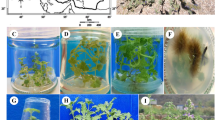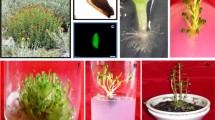Abstract
The present study provides an effective in vitro propagation method for critically endangered parasitic plant Alectra chitrakutensis (M.A. Rau) R. Prasad & R.D. Dixit (Scrophulariaceae). The plant comprises tremendous medicinal properties to treat many diseases such as leprosy, leucoderma, tuberculosis and paralysis. The protocol has been developed using rhizome explant on the modified Murashige and Skoog medium containing various phytohormones to raise complete plantlets without any host interaction. 0.5 mg/l kinetin and 1.0 mg/l NAA was found to be the most excellent medium combination to obtain plantlets with an average shoot length of 11 ± 1.04 cm; and 100% response for rooting. The same medium combination also supported flowering in vitro. Further, comparative molecular and chemical characterization of in vitro and in vivo grown plants were carried out by performing RAPD and HPTLC analysis, respectively, to make sure the genetic as well as chemical stability among the plants. RAPD analysis with MAP (01-20) and OPJ primers (01-20) exhibited a monomorphic band pattern which revealed the genetic similarities among the tested plants. Similarly, presence of azafrin, the most important pharmaceutically active compound in in vitro generated plants indicates the efficacy of protocol to fulfill the objective of in vitro propagation of this critically endangered plant species. Moreover, the present study is the first report towards in vitro conservation of parasitic plant A. chitrakutensis without host from the rhizome explant.




Similar content being viewed by others
Abbreviations
- MS:
-
Murashige and Skoog medium
- WH:
-
White medium
- WPM:
-
Woody plant medium
- BAP:
-
6-Benzylaminopurine
- Kn:
-
Kinetin
- Zn:
-
Zeatin
- IAA:
-
Indole-3-acetic acid
- IBA:
-
Indole-3-butyric acid
- NAA:
-
α Naphthalene acetic acid
- DW:
-
Dry weight
- AU:
-
Arbitrary units
- Rf:
-
Retention factor
References
Agrawal P, Laddha K, Tiwari A (2014) Isolation and method development of azafrin from Alectra parasitica var. chitrakutensis. Nat Prod Res 28:940–944. https://doi.org/10.1080/14786419.2014.896009
Albrecht H, Yoder JI, Phillips DA (1999) Flavonoids promote haustoria formation in the root parasite Triphysaria. Plant Physiol 119:585–591
Amoo SO, Aremu AO, Staden JV (2012) In vitro plant regeneration, secondary metabolite production and antioxidant activity of micropropagated Aloe arborescens Mill. Plant Cell Tissue Org Cult 111:345–358
Anonymous (2010) Medicinal plant species of conservation concern identified for Madhya Pradesh (MP). http://envis.frlht.org—ENVIS Centre on Conservation of Medicinal Plants, FRLHT, Bangalore. http://frlhtenvis.nic.in. Accessed 22 Sept 2010
Anonymous (2013) New application of azafrin. Chinese Patent number CN 201210282959 publication number CN102772397 A and B
Awasthi AK, Gupta A, Goel AK (2008) Alectra parasitica var. chitrakutensis: a rare traditional remedy for Leucoderma and virility in Chitrakoot region of Uttar Pradesh. Ethnobotany 20:154–156
Bandaranayake PCG, Filappova T, Tomilov A, Tomilova NB, McClung DJ, Ngo Q, Inoue K, Yoder JI (2010) A single-electron reducing quinone oxidoreductase is necessary to induce haustorium development in the root parasitic plant Triphysaria. Plant Cell 22:1404–1419
Bedi R (1967) Alectra parasitica var. chitrakutensis. Econ Bot 21:277–283
Bell TL, Adams MA (2011) Attack on all fronts: functional relationships between aerial and root parasitic plants and their woody hosts and consequences for ecosystems. Tree Physiol 31:3–15. https://doi.org/10.1093/treephys/tpq108
Collin HA (2001) Secondary product formation in plant tissue cultures. Plant Growth Regul 34:119–134. https://doi.org/10.1023/A:1013374417961
Coste A, Vlase L, Halmagyi A, Deliu C, Coldea G (2011) Effects of plant growth regulators and elicitors on production of secondary metabolites in shoot cultures of Hypericum hirsutum and Hypericum maculatum. Plant Cell Tissue Organ Cult 106:279–288. https://doi.org/10.1007/s11240-011-9919-5
Deeks SJ, Shamoun SF, Punja ZK (1999) Tissue culture of parasitic flowering plants: method and applications in agriculture and forestry. In Vitro Cell Dev Biol Plant 35:369–381
Doyle JJ, Doyle JL (1987) A rapid DNA isolation procedure for small quantities of fresh leaf tissue. Phytochem Bull 19:11–15
Gasper T, Kevers C, Penel C, Greppin H, Reid DM, Thorpe TA (1996) Plant hormones and plant growth regulators in plant tissue culture. In Vitro Cell Dev Biol Plant 32:272–289
Goyal S, Ramawat KG (2008) Synergistic effect of morphactin on cytokinin-induced production of isoflavonoids in cell cultures of Pueraria tuberosa (Roxb. ex. Willd.) DC. Plant Growth Regul 55:175–181. https://doi.org/10.1007/s10725-008-9271-x
Hussain MS, Fareed S, Ansari S, Rahman MA, Ahmad IZ, Saeed M (2012) Current approaches toward production of secondary plant metabolites. J Pharm Bioallied Sci 4:10–20. https://doi.org/10.4103/0975-7406.92725
Lloyd G, McCown B (1981) Commercially-feasible micropropagation of Mountain laurel, Kalmia latifolia, by use of shoot-tip culture. Int Plant Propag Soc Proc 30:421–427
Luczkiewicz M, Kokotkiewicz A, Glod D (2014) Plant growth regulators affect biosynthesis and accumulation profile of isoflavone phytoestrogens in high-productive in vitro cultures of Genista tinctoria. Plant Cell Tissue Organ Cult 118:419–429. https://doi.org/10.1007/s11240-014-0494-4
Mehrotra S, Khwaja O, Kukreja AK, Rahman L (2012) ISSR and RAPD based evaluation of genetic stability of encapsulated micro shoots of Glycyrrhiza glabra following 6 months of storage. Mol Biotechnol 52:262–268. https://doi.org/10.1007/s12033-011-9491-6
Murashige T, Skoog F (1962) A revised medium for rapid growth and bioassays with tobacco tissue cultures. Physiol Plant 15:473–497
Okonkwo SNC (1975) In-vitro post-germination growth and development of embryos of Alectra (Scrophulariaceae). Physiol Plant 34:378–383
Okonkwo SNC (1991) In-vitro growth response of cultured germinated seeds of witchweed (Striga asiatica). In: Ransom JK, Musselman LJ, Worsham AD, Parker C (ed) Fifth international symposium on parasitic weeds. Nairobi, Kenya, pp 155–163
Parani M, Anand A, Parida A (1997) Application of RAPD fingerprinting in selection of micropropagated plants of Piper longum for conservation. Curr Sci 73:81–83
Prasad R, Dixit RD (1993) An endemic medicinal parasite from Madhya Pradesh under threat of extinction. In: Singh P (ed) Rural reconstruction, ecosystem and forestry. MD Publications Pvt. Ltd, New Delhi, India, pp 185–187
Press MC, Phoenix GK (2005) Impacts of parasitic plants on natural communities. New Phytol 166:737–751
Rajagopalan TR, Seshadri TR (1964) Chemical components of Alectra parasitica. Curr Sci 33:174–175
Rani V, Parida A, Raina SN (1995) Random amplified polymorphic DNA (RAPD) markers for genetic analysis in micropropagated plants of Populus deltoids Marsh. Plant Cell Rep 14:459–462
Saxena AP, Vyas KM (1993) Antimcrobial activity of Alectra parasitica var. chitrakutensis Rau. J Econ Tax Bot 17:55–59
Sharma SK, Bhutya RC (2013) Alectra chitrakutensis (Orobanchaceae) in Bundi District, Rajasthan, India. Taprobanica 5:142–143
Sharma SK, Patil AS, Sikarwar RLS (2016) Comparative phytochemical evaluation of ethnobotanically important medicinal parasitic herb: Alectra chitrakutensis. Int J Pharm Pharm Sci 8:351–355
Sikarwar RLS (2009) Taxonomic status of Alectra chitrakutensis (Rau) R. Prasad & R.D. Dixit. J Econ Tax Bot 33:814–817
Sikarwar RLS (2011) Pharmacopoeial standardization of Alectra chitrakutensis (M. A. Rau.) R. Prasad & R. D. Dixit found in Chitrakoot region. J Nat Rem 1:124–131
Sikarwar RLS (2013) Chitrakoot—an emporium of biological and cultural diversity. In: Tripathi IP (ed) Chemistry, biochemistry and ayurveda of indian medicinal plants. MGCV, Chitrakoot, pp 87–93
Sikarwar RLS, Tiwari AK (2010) Exploitation, utilization and conservation of endemic and critically endangered ethno-medicinal plant species Alectra chitrakutensis in the Chitrakoot region. Ethnobotany 22:125–127
Sikarwar RLS, Jaiswal A, Kumar V (2005) Medicinal uses of Alectra chitrakutensis. J Trop Med Plants 6:93–97
Tandon VR (2005) Medicinal uses and biological activities of Vitex negundo. Nat Prod Radiance 4:154–155
Ved DK, Kinhal GA, Ravikumar K, Karnat M, Vijaya Sankar R, Indresha JH (2003) Threat assessment and management prioritization for medicinal plants of Chhattisgarh & Madhya Pradesh. ABIM—An Annotated Bibliography of Indian Medicine, vol 4, Foundation for Revitalization of Local Health Traditions, Bangalore
Vishwanathan AS, Basavaraju R (2010) A review on Vitex negundo L.—a medicinally important plant. EJBS 3:30–42
Yoder JI (1999) Parasitic plant responses to host plant signals: a model for subterranean plant–plant interactions. Curr Opin Plant Biol 2:65–70
Acknowledgements
The authors are grateful to Prof. M.K. Rai, Head, Department of Biotechnology, Sant Gadge Baba Amravati University, Amravati (M.S.) for providing necessary laboratory facilities required for study. They are also thankful to Dr. P.B. Kale, Director, Mahatma Gandhi Institute for Rural Industrialization, Wardha (M.S.) for providing essential facilities time to time during the entire period of study. Funding was provided by Ministry of Micro, Small and Medium Enterprise, Gov. of India, New Delhi, India (Grant no. C-3).
Author information
Authors and Affiliations
Corresponding author
Additional information
Communicated by E. Dziedzic.
Rights and permissions
About this article
Cite this article
Sharma, S.K., Patil, A., Agnihotri, A.K. et al. In vitro conservation of Alectra chitrakutensis: a critically endangered root parasitic plant of high medicinal importance. Acta Physiol Plant 40, 29 (2018). https://doi.org/10.1007/s11738-018-2606-y
Received:
Revised:
Accepted:
Published:
DOI: https://doi.org/10.1007/s11738-018-2606-y




